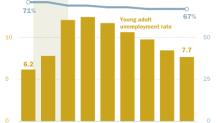Employment among young people has bounced back from Great Recession lows, but you wouldn’t know it by their living arrangements, according to a new Pew Research Center study.
Young people are more likely to live at home now than they were in 2007, a trend that could have major implications for the nation's housing industry.
Overall, the job outlook for for Americans 18 to 34 is greater than it has been in the recent past. Unemployment fell from a high of 12.4 percent in 2010 to 7.7 percent this year.
But the number of young adults living independently has continued to decline, from 71 percent in 2007 to 67 percent in 2015. Twenty-six percent of young people lived in a parent's home in 2015. When the unemployment rate peaked in 2010, 24 percent did.

A college education is correlated with greater personal independence, Pew found. Seventy-five percent of young Americans with only a high school education or less lived independently, compared with 86 percent of those with a degree. Still, young people of all educational backgrounds are more likely to live at home now than they were in 2007.
Ironically, the accomplishment that has made it easier for many young people to seek better employment and greater independence, a college education, has also held back many from moving out and buying homes. Young Americans’ burdensome student loan debt has discouraged many of them from leaving home.
U.S. & World
Although there are nearly three million more Americans aged 18 to 34 now than there were in 2007, the number of households run by young adults has stayed flat.
Young people taking longer to move out may have wider consequences on the nation’s housing market and related industries, the study found. That could mean everything from fewer furniture purchases to cable installations.



